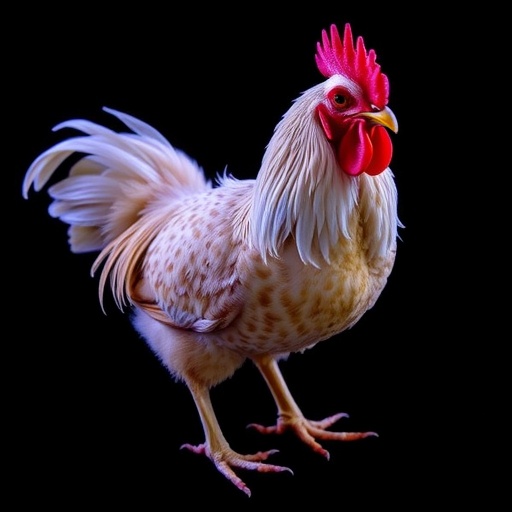Recent research has shed new light on the complexities of gonadal development in chickens, emphasizing the role of RASA1 expression and its relationship with Z/W dosage dynamics. This study, conducted by a team of researchers including Xue, Lv, and Li, was published in BMC Genomics and represents a significant leap forward in our understanding of avian biology, particularly in the context of sexual differentiation.
The Z/W sex-determination mechanism in chickens is largely dictated by the presence of differing sex chromosomes, which bears a notable resemblance to the X/Y system observed in mammals. However, the intricacies of how gene expression varies between these two systems have long posed questions within the field. Understanding how RASA1 expression mediates these differences provides crucial insights into the evolutionary adaptations of birds. The precise regulation of RASA1 and its associated pathways can have far-reaching implications for avian reproduction and development.
RASA1, or Ras protein activator 1, is a critical gene involved in multiple signaling pathways that govern cell proliferation and differentiation. It serves as a GTPase-activating protein that regulates the Ras signaling pathway, which is essential for various physiological processes. The study meticulously examines how RASA1 expression fluctuates in differing dosage scenarios between the Z and W chromosomes, ultimately influencing the developmental trajectory of gonads in chickens.
Through a combination of transcriptomic and genomic techniques, the research team was able to quantify RASA1 expression levels across chicken embryos of various developmental stages. Conducting RNA sequencing, the team identified significant variances in RASA1 expression that corresponded to the embryonic stage and the sex of the embryos. These findings shed light on the central role of RASA1 in embryonic development and its potential influence in determining the sexual phenotype.
One of the standout observations of the study was the observation that differential expression of RASA1 had immediate and observable effects on gonadal development. Higher levels of expression in male embryos correlated with the activation of pathways associated with male gonadal differentiation, while lower levels or disruptions in expression in female embryos pointed to incomplete or altered ovarian development. This distinction underscores the gene’s pivotal involvement in the sex differentiation process.
Beyond developmental implications, the research also led to discussions on the evolutionary significance of RASA1 in chickens. By comparing findings across species, the researchers hinted at a conserved mechanism that might span various avian species and highlight the importance of specific gene expressions in reproductive biology. The evolutionary narrative these findings suggest offers an exciting avenue for further exploration into the genetics of sexual differentiation.
Additionally, the investigation into RASA1 expression dynamics has implications in understanding fertility and reproductive health not just in chickens but potentially across other species. With poultry being a significant source of protein globally, understanding the genetic underpinnings that dictate gonadal development could lead to improved breeding practices and greater agricultural efficiency.
Such findings also provoke interesting debates within the scientific community regarding the ethics and implications of genetic manipulation. If RASA1 can so distinctly influence gonadal outcomes, inquiries into the potential consequences of modifying such gene expressions for practical benefits are inevitable. These discussions are not merely academic; they hold real-world implications for agricultural practices and biodiversity conservation efforts.
Furthermore, the implications extend to broader applications in understanding fertility issues in other species, including humans. If RASA1 or related genes play similar roles across different species, insights gleaned from this avian study could help unravel some of the complexities of sex differentiation and reproductive health in mammals. The parallels drawn by researchers could serve as a bridge, linking avian genetic studies to mammalian developmental biology.
The research also explores the environmental factors that could affect RASA1 expression, suggesting an interplay between genetic predisposition and external conditions. Understanding how such factors integrate could provide pivotal knowledge in developing strategies to mitigate the impacts of environmental changes on reproductive success in avian populations.
This study is indeed a significant contribution to the field of genomics and avian developmental biology, paving the way for future research that may further elucidate the roles of key genes like RASA1 in the broader context of sexual differentiation and reproductive health. The findings not only enhance our understanding of basic biological processes but also extend to applied sciences, emphasizing the importance of genetic research in species conservation and agricultural advancement.
As scientists continue to deepen their understanding of avian genetics and development, the potential benefits of these discoveries ripple through various areas of biology, agriculture, and environmental science. The ongoing research into the dynamics of RASA1 and its influence on Z/W dosage will undoubtedly spur further inquiry and, with it, more surprising revelations about the mechanisms underpinning life itself.
In summary, the investigation into RASA1 expression provides an essential perspective on the complex interplay of genetics in gonadal development, shaping our knowledge of avian biology while suggesting broader implications for diversity in nature.
Subject of Research: The role of RASA1 expression in Z/W dosage dynamics and gonadal development in chickens.
Article Title: RASA1 expression highlights Z/W dosage dynamics and gonadal development in chickens.
Article References:
Xue, Y., Lv, M., Li, J. et al. RASA1 expression highlights Z/W dosage dynamics and gonadal development in chickens. BMC Genomics 26, 1024 (2025). https://doi.org/10.1186/s12864-025-12222-4
Image Credits: AI Generated
DOI: https://doi.org/10.1186/s12864-025-12222-4
Keywords: RASA1, Z/W dosage, gonadal development, chicken genetics, sex differentiation, avian biology, RNA sequencing, gene expression.
Tags: avian sexual differentiationBMC Genomics research findingschicken gonad development studiesdifferences between Z/W and X/Y systemsdosage effects on RASA1evolutionary adaptations in birdsgene regulation in gonadsgonadal development in birdsimplications for avian reproductionRas signaling pathway in chickensRASA1 gene expression in chickensZ/W sex-determination mechanism





